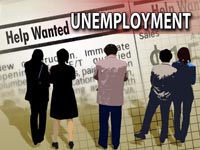Unemployment Down – Not Because of Greater Employment
 Staff Reports
Staff Reports
Exodus Occurred Among Almost All Education Groups.
According to Lawrence Mishel of the Economic Policy Institute, unemployment in November dipped to 8.6 percent, its lowest point since March 2009, down from its 10.1 percent recession high in Oct. 2009.
The unemployment rate fell because the share of the population seeking work or working, and the labor force participation rate has fallen considerably. We know this because the share of the population employed November—58.5 percent—is the same as when the unemployment rate peaked.
The lack of change in the share of the population employed—known as the
employment-to-population ratio—indicates that the growth in employment
has only kept pace with the growth of the working-age population. The
figure shows the erosion in the labor force participation rate of people
age 25 and older by education level over the last two years.

For the 8 percent of the labor force who have not completed high
school, there was no real fall in labor force participation as the small
decline from 2009–10 roughly offset the small increase from 2010–11. In
contrast, labor force participation of those with a high school degree
or some college declined by 1.6 percentage points, with the greatest
decline occurring in the last year.
There was a somewhat smaller but still sizable 1.3 percentage-point
decline in labor force participation of those with a college degree or
further education (such as a master’s or professional degree). Thus,
this deep recession led to a widespread shrinkage of the labor force
that encompasses all but the least-educated workers.






